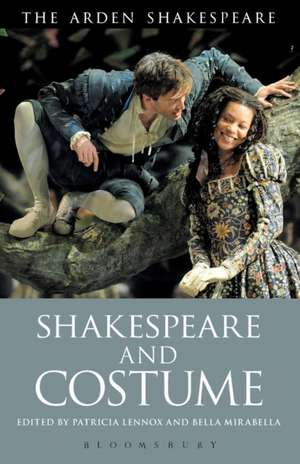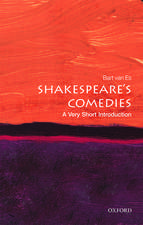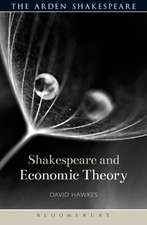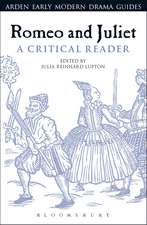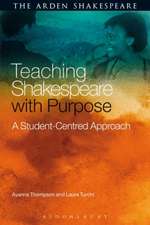Shakespeare and Costume
Editat de Patricia Lennox, Bella Mirabellaen Limba Engleză Paperback – 24 aug 2016
| Toate formatele și edițiile | Preț | Express |
|---|---|---|
| Paperback (1) | 236.54 lei 6-8 săpt. | |
| Bloomsbury Publishing – 24 aug 2016 | 236.54 lei 6-8 săpt. | |
| Hardback (1) | 713.72 lei 6-8 săpt. | |
| Bloomsbury Publishing – 25 feb 2015 | 713.72 lei 6-8 săpt. |
Preț: 236.54 lei
Preț vechi: 272.16 lei
-13% Nou
Puncte Express: 355
Preț estimativ în valută:
45.26€ • 47.38$ • 37.45£
45.26€ • 47.38$ • 37.45£
Carte tipărită la comandă
Livrare economică 05-19 aprilie
Preluare comenzi: 021 569.72.76
Specificații
ISBN-13: 9781350004474
ISBN-10: 1350004472
Pagini: 312
Ilustrații: 20 illus
Dimensiuni: 129 x 198 x 17 mm
Greutate: 0.3 kg
Ediția:NIPPOD
Editura: Bloomsbury Publishing
Colecția The Arden Shakespeare
Locul publicării:London, United Kingdom
ISBN-10: 1350004472
Pagini: 312
Ilustrații: 20 illus
Dimensiuni: 129 x 198 x 17 mm
Greutate: 0.3 kg
Ediția:NIPPOD
Editura: Bloomsbury Publishing
Colecția The Arden Shakespeare
Locul publicării:London, United Kingdom
Caracteristici
Interviews
with
leading
theatre
practitioners
(including
Joan
Greenwood,
Desmond
Heeleu,
Robert
Morgan
and
Jenny
Tiramani)
add
value
and
relevance
Notă biografică
Patricia
Lennoxis
Global
Lecturer
at
New
York
University,
USA.Bella
Mirabellais
Associate
Professor
at
NYU
Gallatin,
USA.
She
specializes
in
Renaissance
studies,
with
a
focus
on
drama,
theater,
performance
and
gender.
Cuprins
AbbreviationsList
of
illustrationsAcknowledgementsList
of
contributorsIntroduction,
Patricia
Lennox
and
Bella
MirabellaBrief
Overview:
A
Stage
History
of
Shakespeare
and
Costume,
Russell
JacksonPart
I:
Dressing
Shakespeare
in
His
Own
Time-Theatre,
Fashion,
and
Social
Practice1.
'The
Compass
of
a
Lie'?
Royal
Clothing
at
Court
and
in
the
Plays
of
Shakespeare,
1598-1613,
Maria
Hayward,
University
of
Southampton,
UK2.
Suits
of
Green:
Festive
Livery
on
Shakespeare's
Stage,
Erika
T.
Lin,
George
Mason
University,
USA3.
'Honest
Clothes'
inThe
Merry
Wives
of
Windsor,
Catherine
Richardson,
University
of
Kent,
UK4.
How
to
Do
Things
with
Shoes,
Natasha
Korda,
Wesleyan
University,
USA5.
'Apparel
oft
Proclaims
the
Man':
Dressing
Othello
on
the
English
Renaissance
Stage,
Bella
Mirabella,
NYU
Gallatin,
USAPart
II:
Designing
Shakespeare:
Theatrical
Practice
and
Costume6.
"The
Stylish
Shepherd,
or,
What
to
Wear
inAs
You
Like
It's
Forest
of
Arden,
Russell
Jackson,
University
of
Birmingham,
UK7.
How
Designers
Helped
Juliet's
Nurse
Reclaim
her
Bawdy,
Patricia
Lennox,
NYU
Gallatin,
USA8.
Shakespeare
Stripped:
Costuming
Prisoner-of-war
Entertainments
and
Cabaret,
Kate
Dorney,
Victoria
and
Albert
Museum,
London,
UKPart
III:
Interviews
with
Contemporary
Designers9.
The
Designers,
Joan
Greenwood
and
Robert
Morgan
Notes
Index
Recenzii
The
collection
is
strongest
on
early
modern
material
.
[and]
essays
on
more
modern
sumptuary
topics
are
enjoyably
well
informed
A rich resource for the study of what turns out to be frippery in the best sense.
Featured in
Mining playtexts, archives, and clothing materials, contributors in Shakespeare and Costume explore what actors wore throughout past centuries, how they used clothing in their performances, and what meaning costumes conveyed. . The essays in this volume give these costumes a voice and students and stage practitioners an ear to understand a lost language through which materially based visual codes once spoke.
Shakespeare and Costumeembodies the diversity of work on dress's interaction with early modern theatre and culture in a series of essays and interviews by an interdisciplinary array of authors . Addressing past, present, and future explorations, editors Patricia Lennox and Bella Mirabella ensure readers gain useful historical context on trends in Shakespearean costume and its analysis, experience multiple analytical perspectives of current research, and also see new avenues for investigation . It encourages a new approach to oft-discussed topics in Shakespeare and theatre studies-race, royalty, festive customs, production design, gender, early modern morality, and so on-through attention to costume. Novices will benefit from a complete read, but seasoned experts will more likely turn to specific essays that pertain to their particular interests. In terms of the field, this book is a welcome garment in an already quite full closet. It asks that when we attend to early modern costume, we look not only at an entire outfit, but also think about the implications of a fabric, a lone headpiece, a single shoe-letting the encompassing nature of "costume" stimulate new avenues of research.
A rich resource for the study of what turns out to be frippery in the best sense.
Featured in
Mining playtexts, archives, and clothing materials, contributors in Shakespeare and Costume explore what actors wore throughout past centuries, how they used clothing in their performances, and what meaning costumes conveyed. . The essays in this volume give these costumes a voice and students and stage practitioners an ear to understand a lost language through which materially based visual codes once spoke.
Shakespeare and Costumeembodies the diversity of work on dress's interaction with early modern theatre and culture in a series of essays and interviews by an interdisciplinary array of authors . Addressing past, present, and future explorations, editors Patricia Lennox and Bella Mirabella ensure readers gain useful historical context on trends in Shakespearean costume and its analysis, experience multiple analytical perspectives of current research, and also see new avenues for investigation . It encourages a new approach to oft-discussed topics in Shakespeare and theatre studies-race, royalty, festive customs, production design, gender, early modern morality, and so on-through attention to costume. Novices will benefit from a complete read, but seasoned experts will more likely turn to specific essays that pertain to their particular interests. In terms of the field, this book is a welcome garment in an already quite full closet. It asks that when we attend to early modern costume, we look not only at an entire outfit, but also think about the implications of a fabric, a lone headpiece, a single shoe-letting the encompassing nature of "costume" stimulate new avenues of research.
